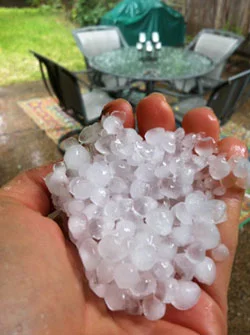Hail-Proof Plants? Hail Yeah.
- 2023-11-06
- By mkirk
- Posted in Horticulture, The Garden Buzz
By Caitlin Tongco, Colorado Master Gardener
March may “come in like a lion and go out like a lamb,” however the weather this spring was more like a ferocious dragon. Historically, Colorado has its fair share of hit-or-miss weather. But the spring and summer of 2023 was one for the record books (literally). Let’s do a weather recap before we dive into how our gardens fared this year.

While we eagerly awaited the perfect weather for transplanting vegetable starts, Mother Nature had other plans. The primary month to start transplanting tomatoes, and other warm-season plants, ended up being dreary, cold, and WET. June 2023 became the rainiest June on record for Denver with 6.10 inches of precipitation recorded throughout the month. By the end of June, Denver was already at 99% of its annual average precipitation. With less light, plants use less water. The lack of sun paired with the onslaught of rain created a subpar environment to kick off the gardening season. This caused a lack of root development and top growth for any plant started.
The rain did not stop in June. By the end of July, the National Weather Service had issued 892 severe thunderstorm warnings. By definition, a severe thunderstorm can produce one inch or bigger-diameter hail. By August, there were around 1,400 severe thunderstorm reports. For reference, 2022 only had 500 thunderstorm reports. And while these thunderstorms were bad, the hail that came with these storms did the most damage. In 2023, there were over 70 days in which large hailstorms were reported in Denver. This was a new record for hail-producing storms.

While the summer might have been one of the first since 2015 to not have a 100° day, September 1brought in a record high of 99° (swiftly following on another record high of 99° on August 21). For the weather year through September 2023, Colorado has recorded five record lows and four record highs.
With this chaotic weather, some gardens thrived while others died. Some gardeners threw in the trowel. However, the Arapahoe County Master Gardeners persevered and maintained eight community gardens throughout the county. Their experiences from this year have provided insight into the best and worst performing plants even with the hail, storms and temperature swings.
Gardens in Arapahoe County maintained by Colorado Master Gardener volunteers experienced the same weather challenges home gardeners did. Almost every garden was hit with hail, and some were struck with multiple hailstorms. Midseason, volunteers had to replant or nurse existing plants back to health.

In the gardens hit hardest with hail, root vegetables and cruciferous vegetables were the main stars of the show. The Silo Park Garden in Greenwood Village mentioned both turnips (Purpletop White Globe) and radishes (French Breakfast) as prolific producers. The Cheyenne Arapahoe Garden also recommended radishes. In addition to these two options – carrots, artichokes, chard, cabbage, and kale were also top performers in multiple gardens. Volunteers at Hudson Gardens in Littleton also successfully grew a variety of romaine lettuce (Forellenschluss) throughout this stormy season.
Other gardens in the Littleton and Englewood area, including Pea Patch, Colorado Center for the Blind, and Clayton Elementary, found success with zucchini and peppers. Clayton Elementary escaped the onslaught of hail. Volunteers at this garden grew a large variety of tomatoes with the best performers being Beefsteak and Cherokee Purple. In most gardens hit by hail, the tomato crop was not prolific. Cucumbers were another common low-production vegetable this season. As a result of the wetter weather, squash and cucumbers were affected heavily by powdery mildew. Calendula and marigolds were commonly affected by aster yellows – more so than in previous years.

Gardening in Colorado is tough and is heavily dependent on factors outside of our control. Weather can create challenges even for experienced gardeners. Ideally, the above information can help inform us on what we plant for more prolific seasons. While we cannot change the weather, we can learn to be flexible and change how and what we plant to better accommodate ever-changing weather conditions.
Horticulture Resources
- Garden Buzz Archives
- CSU Extension Resources
- Colorado Master Gardener Program
- Foothills to Plains Native Plant Master Program
- Native Bee Watch Community Science Program
- The Co-Hort Blog
- PlantTalk Colorado
- Soil Testing
- Plant Select
- Emerald Ash Borer
- Japanese Beetle
- Colorado State Forest Service
- Ask an Expert


